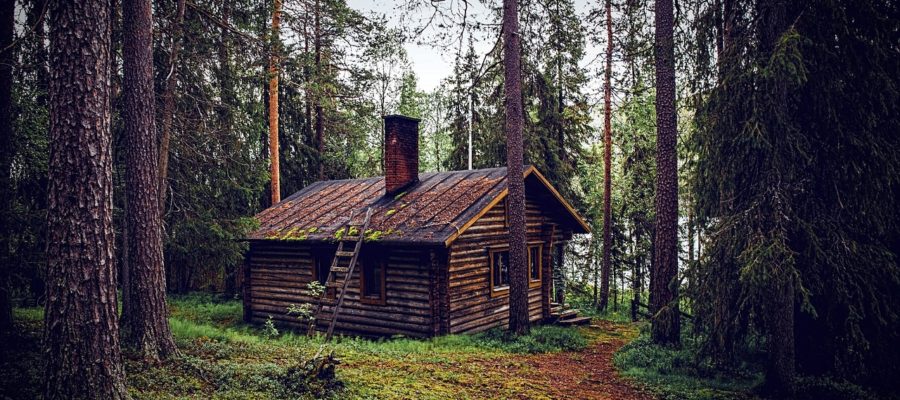Global population has almost hit 8 billion, and the life dream of many people to become homeowners during their time on this planet is stronger than ever. Approximately 68% of Americans own their own home right now, compared to 42% of residents in Germany and 85% in Spain. Of course, owning your home and being debt-free are two completely different animals. While America is considered the land of opportunity and part of that opportunity involves land and property ownership, the housing crisis and literature have successfully beaten into our skulls a continuous theme: The best-laid plans of mice and men often go awry. A log home can fulfill those lifelong dreams while keeping your finances grounded, especially if you opt to go tiny.
Some of the Best Things Come in Small Packages
At the turn of the 20th century, the size of the average American home was 800 square feet. That’s a decent-sized two-bedroom apartment in many cities today. While the homes were small, they catered to the needs of hardworking parents and a couple of kids. Most family activities were outdoors at that time, so finding or creating space for big screen TVs and multiple gaming consoles or computing needs wasn’t an issue.
The Tiny House Movement began in 2004 as an intelligent reaction to the destruction of Hurricane Katrina. When architects Sarah Susanka and Marianne Cusato put their brilliant minds together, utilizing their specific talents and specialties, magic occurred. And the fact that they’re clear examples of the term “girl power” certainly didn’t hurt matters one bit. Since tiny homes can be as unique and different as the people who live inside them, it’s no wonder this phenomenon has grown to include the newest trend in log cabins.
What’s the Difference Between an Average Home and a Tiny House?
The average sized new home in America today is almost 3,000 square feet at a cost just shy of $400,000. Usually, the decision to opt for an expensive mortgage or a mortgage refinance on your current home is preceded or punctuated by a work promotion, strong realtor sales pitch, deep desire to impress others, or the belief that a certain sized home with all the bells and whistles will be the home of their dreams. The small house movement consists of homeowners dedicated to returning to a more controllable way of life. It begins with homesteads with fewer than 1,000 square feet of living area. However, there is a distinct difference between small and tiny homes. The latter category reduces the maximum internal living space to 400 square feet. And the average cost of such a home is often less than the price of a new car.
Over 10 million viewers watch cable-based tiny home shows. There are also multiple blogs and an entire magazine devoted to tiny house living. So the concept is anything but a trend; it’s quickly becoming an American pastime. While multiple materials and containers can be used for a tiny home, log cabins are hitting the scene as one of the most coveted options.
A tiny log cabin does require detailed preparation, land access, and determination, but the results can be stunning. And since there are plenty of free resources to discovering each step of the process from permit requirements to acquiring the best log stain for sale, your new little log cabin can become the true home of your dreams as you live the life you were finally meant to have. But what are the real benefits of choosing wood over other building materials?
What Are the Benefits of Going the Wood Route?
Concepts and styles of log cabins have changed drastically since the settler days. What used to be a shell meant solely for protection from the elements and wilderness has evolved into beauty, elegance, and expressive living. Of course, wood is also a natural insulator and energy saver. Inorganic materials such as steel, glass, and masonry expand when heated. Wood has an opposite reaction. And when wood dries, it actually becomes harder.
The right wood can be environmentally friendly, reduce carbon, and be a healthier option for your entire household’s health and well-being. Wood products have the natural ability to absorb carbon. While cutting into today’s tree stash may seem counterproductive, responsibly sourced wood suppliers can provide a connection that restores and replaces the used wood, thus continuing the growth cycle. Since cubic meter of wood saves 0.8 tons of construction-based carbon emissions, your tiny log cabin can have a big impact on the planet.
Wood can be used throughout a tiny cabin dwelling to ensure an aesthetically pleasing appearance throughout your home. While many types of wood do absorb water, specific types actually repel moisture and precipitation. Unlike other materials, designing and decorating with and around wood is not limited to specific decor styles. With a tiny log cabin kit, the beauty of your home is only restricted by the confines of your imagination.
Yasmin Marsden yearns for the simple life and has just started to build her tiny home after a few years of planning and research. She writes about tiny living and her need for a simpler life.


